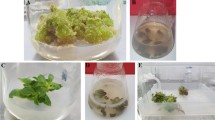Abstract
Reproduction by three isolates ofPhoma medicaginis growing on potato dextrose agar was studied. The formation of pycnidia was optimum at 30°C whereas the optimum for the formation of conidia was 20°C. Light consistently increased the numbers of pycnidia and conidia over those formed in darkness and more conidia were produced in light at 23°C than at 30°C. The effects of carbon and nitrogen sources on reproduction were studied using modified Richard's medium as the basal medium. Fourteen carbohydrates, 11 amino acids, 9 inorganic nitrogen sources and urea were evaluated by replacing the carbohydrate or nitrogen in Richard's medium with the test substance. Generally, the monosaccharides and disaccharides were about alike and superior to polysaccharides for the production of pycnidia. The carbon sources were about equally useful for production of conidia, but the polysaccharides were superior to the other two classes of carbon sources when the number of conidia/pycnidium was calculated. Generally, the formation of pycnidia and conidia was favored by nitrate more than by ammonium nitrogen sources. The average number of conidia/pycnidium was greatest, however, when the nitrogen source was NH4NO3. All amino acids tested appeared to be useful nitrogen sources for production of pycnidia but none were especially good for conidia production. L-isoleucine was superior to the other amino acids tested. Of three isolates used, Illinois 23 consistently produced more pycnidia and conidia that did isolates Minnesota 2 and Missouri 5. Usually the significant interactions between isolates and other treatments were due to a greater response by isolate Ill. 23. It was concluded that the reproduction ofP. medicaginis varies significantly with the isolates of the fungus, the environment, and nutrients as well as with interactions among these factors, and conclusions about the influence of a particular factor will depend on whether the formation of pycnidia, conidia or conidia/pycnidium is being studied.
Similar content being viewed by others
References
Bennett, C. W. (1921) A phoma root rot of celery. Mich. State Univ. Expt. Station Tech. Bull. 53. 40 p.
Calpouzos, L. &Lapis, D. B. (1970) Effects of light on pycnidium formation, sporulation, and tropism bySeptoria nodorum.Phytopathology 60:791–794.
Cochrane, V. W. (1958) Physiology of fungi. John Wiley & Sons, Inc. New York. 524 p.
Coons, G. H. (1916) Factors involved in the growth and pycnidium formation ofPlenodomus fuscomaculans.J. Agr. Res. 5:713–769.
Coons, G. H. &Levin, E. (1921) The relation of light to pycnidium formation in the Sphaeropsidales.Mich. Acad. Sci. Report 22:209–213.
Cormack, N. W. (1945) Studies onAscochyta imperfecta, a seed- and soil-borne parasite of alfalfa.Phytopathology 35:838–855.
Covey, R. P., Jr. (1962) Field resistance of flax to pasmo. Ph.D. Thesis. University of Minnesota, St. Paul, Minneosta. 73 p.
Fulkerson, J. F. (1955) The relation of light to the production of pycnidia byPhysalospora obtusa.Phytopathology 45:22–25.
Guba, E. F. (1925)Phyllosticta leaf spot, fruit blotch and canker of the apple: Its etiology and control.Ill. Agr. Expt. Sta. Bull. 256. 77 p.
Hawker, Lilian E. (1957) The physiology of reproduction in fungi. Cambridge University Press. London. 128 p.
Hawker, Lilian E. (1966) Environmental influences on reproduction. p. 435–465. InG. C. Anisworth andA. S. Sussman (ed.), the Fungi. Vol. II. Academic Press, New York.
Kernkamp, M. F. &Hemerick, G. A. (1953) The relation ofAscochyta imperfecta to alfalfa seed production in Minnesota.Phytopathology 43:378–382.
Leach, C. M. (1962) Sporulation of diverse species of fungi under near ultraviolet radiation.Canad. J. Bot. 40:151–161.
Leach, C. M. (1962) The quantitative relationship of ultraviolet and visible radiation on the induction of reproduction inAscochyta pisi.Canad. J. Bot. 40:1577–1602.
Leonian, L. H. (1924) A study of factors promoting pycnidium formation in some Sphaeropsidales.Amer. J. Bot. 9:19–50.
Lilly, V. G. &Barnett, H. H. (1951) Physiology of the fungi. McGraw-Hill Book Co., Inc. New York. 464 p.
Mead, H. W. (1953) Studies on black stem of alfalfa caused byAscochyta imperfecta Peck. I. Seed and seedling phases of the disease.Canad. J. Agr. Sci. 33:500–505.
Mead, H. W. (1962) Studies onAscochyta imperfecta Peck. Factors affecting sporulation of Canadian isolates on natural and artiticial media.Canad. J. Bot. 40:263–271.
Mead, H. W. (1962) Studies onAscochyta imperfecta Peck. Changes in physical characteristics of Canadian isolates on agar amended with various amino acids.Canad. J. Bot. 40:1365–1370.
Mead, H. W. (1965) Resume of data on black stem of alfalfa caused byAscochyta imperfecta Peck.Canad. Plant Dis. Survey 44:134–141.
Mix, A. J. (1933) Factors affecting the sporulation ofPhyllosticta solitaria in artificial culture.Phytopathology 23:503–524.
Peterson, M. L. &Melchers, L. E. (1942) Studies on black stem of alfalfa caused byAscochyta imperfecta.Phytopathology 32:590–597.
Renfro, B. L. &Wilcoxson, R. D. (1963) Production and storage of inoculum ofPhoma herbarum var.medicaginis.Plant Dis. Rep. 47:168–169.
Richards, G. S. (1951) Factors influencing sporulation bySeptoria nodorum.Phytopathology 41:571–578.
Riker, A. J. &Riker, Regina S. (1936) Introduction to research on plant disease. John S. Swift Co., Chigaco. 117 p.
Satour, M. M., Webster, R. K. &Hewitt, W. B. (1969) Studies onDiploida andDiploida-like fungi. I. Effects of carbon sources on certain taxonomic characters and on growth in agar culture.Hilgardia 39:601–629.
Satour, M. M., Webster, R. K. &Hewitt, W. B. (1969) Studies onDiplodia andDiploida-like fungi. II. Effects of nitrogen sources on growth, sporulation, and certain taxonomic characters.Hilgardia 39:631–653.
Schenck, N. C. &Gerdmann, J. W. (1956) Taxonomy, pathogenicity, and host parasite relations ofPhoma trifollii andPhoma herbarum var.medicaginis.Phytopathology 56:194–200.
Steel, R. G. D. &Torrie, J. H. (1960) Principles and procedures of statistics. McGraw-Hill Book Co., Inc. New York. 481 p.
Tandon, R. N. &Bilgrami, K. S. (1957) Nitrogen nutrition ofPhyllostica artocarpina (Syd. &Butl.)Proc. Nat. Acd. Sci. India. 27B:269–273.
Author information
Authors and Affiliations
Additional information
Paper No. 7425, Scientific Journal Series, Minnesota Agricultural Experiment Station.
Rights and permissions
About this article
Cite this article
Chung, H.S., Wilcoxson, R.D. Effects of temperature, light, carbon and nitrogen nutrition on reproduction in Phoma medicaginis. Mycopathologia et Mycologia Applicata 44, 297–308 (1971). https://doi.org/10.1007/BF02052703
Accepted:
Published:
Issue Date:
DOI: https://doi.org/10.1007/BF02052703




